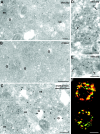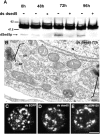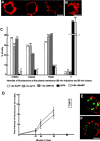A novel role for dp115 in the organization of tER sites in Drosophila
- PMID: 12876273
- PMCID: PMC2172793
- DOI: 10.1083/jcb.200301136
A novel role for dp115 in the organization of tER sites in Drosophila
Abstract
Here, we describe that depletion of the Drosophila homologue of p115 (dp115) by RNA interference in Drosophila S2 cells led to important morphological changes in the Golgi stack morphology and the transitional ER (tER) organization. Using conventional and immunoelectron microscopy and confocal immunofluorescence microscopy, we show that Golgi stacks were converted into clusters of vesicles and tubules, and that the tERs (marked by Sec23p) lost their focused organization and were now dispersed throughout the cytoplasm. However, we found that this morphologically altered exocytic pathway was nevertheless largely competent in anterograde protein transport using two different assays. The effects were specific for dp115. Depletion of the Drosophila homologues of GM130 and syntaxin 5 (dSed5p) did not lead to an effect on the tER organization, though the Golgi stacks were greatly vesiculated in the cells depleted of dSed5p. Taken together, these studies suggest that dp115 could be implicated in the architecture of both the Golgi stacks and the tER sites.
Figures









Similar articles
-
dGRASP localization and function in the early exocytic pathway in Drosophila S2 cells.Mol Biol Cell. 2005 Sep;16(9):4061-72. doi: 10.1091/mbc.e04-10-0938. Epub 2005 Jun 22. Mol Biol Cell. 2005. PMID: 15975913 Free PMC article.
-
Role of syntaxin 18 in the organization of endoplasmic reticulum subdomains.J Cell Sci. 2009 May 15;122(Pt 10):1680-90. doi: 10.1242/jcs.036103. Epub 2009 Apr 28. J Cell Sci. 2009. PMID: 19401338
-
Sec16 is a determinant of transitional ER organization.Curr Biol. 2005 Aug 23;15(16):1439-47. doi: 10.1016/j.cub.2005.06.065. Curr Biol. 2005. PMID: 16111939
-
The Golgi apparatus: lessons from Drosophila.FEBS Lett. 2009 Dec 3;583(23):3827-38. doi: 10.1016/j.febslet.2009.09.048. Epub 2009 Oct 1. FEBS Lett. 2009. PMID: 19800333 Review.
-
Dynamic structure and function of Golgi apparatus in the salivary acinar cells.J Electron Microsc (Tokyo). 1995 Jun;44(3):124-34. J Electron Microsc (Tokyo). 1995. PMID: 7673810 Review.
Cited by
-
Retrograde traffic from the Golgi to the endoplasmic reticulum.Cold Spring Harb Perspect Biol. 2013 Jun 1;5(6):a013391. doi: 10.1101/cshperspect.a013391. Cold Spring Harb Perspect Biol. 2013. PMID: 23732476 Free PMC article. Review.
-
Identification of a functional domain within the p115 tethering factor that is required for Golgi ribbon assembly and membrane trafficking.J Cell Sci. 2012 Apr 15;125(Pt 8):1896-909. doi: 10.1242/jcs.090571. Epub 2012 Feb 10. J Cell Sci. 2012. PMID: 22328511 Free PMC article.
-
Drosophila Tempura, a novel protein prenyltransferase α subunit, regulates notch signaling via Rab1 and Rab11.PLoS Biol. 2014 Jan 28;12(1):e1001777. doi: 10.1371/journal.pbio.1001777. eCollection 2014 Jan. PLoS Biol. 2014. PMID: 24492843 Free PMC article.
-
The Physiological Functions of the Golgin Vesicle Tethering Proteins.Front Cell Dev Biol. 2019 Jun 18;7:94. doi: 10.3389/fcell.2019.00094. eCollection 2019. Front Cell Dev Biol. 2019. PMID: 31316978 Free PMC article. Review.
-
The Golgi ribbon structure facilitates anterograde transport of large cargoes.Mol Biol Cell. 2014 Oct 1;25(19):3028-36. doi: 10.1091/mbc.E14-04-0931. Epub 2014 Aug 7. Mol Biol Cell. 2014. PMID: 25103235 Free PMC article.
References
-
- Allan, B.B., B.D. Moyer, and W.E. Balch. 2000. Rab1 recruitment of p115 into a cis-SNARE complex: programming budding COPII vesicles for fusion. Science. 289:444–448. - PubMed
-
- Alvarez, C., R. Garcia-Mata, H.P. Hauri, and E. Sztul. 2001. The p115-interactive proteins GM130 and giantin participate in endoplasmic reticulum-Golgi traffic. J. Biol. Chem. 276:2693–2700. - PubMed
Publication types
MeSH terms
Substances
LinkOut - more resources
Full Text Sources
Molecular Biology Databases

